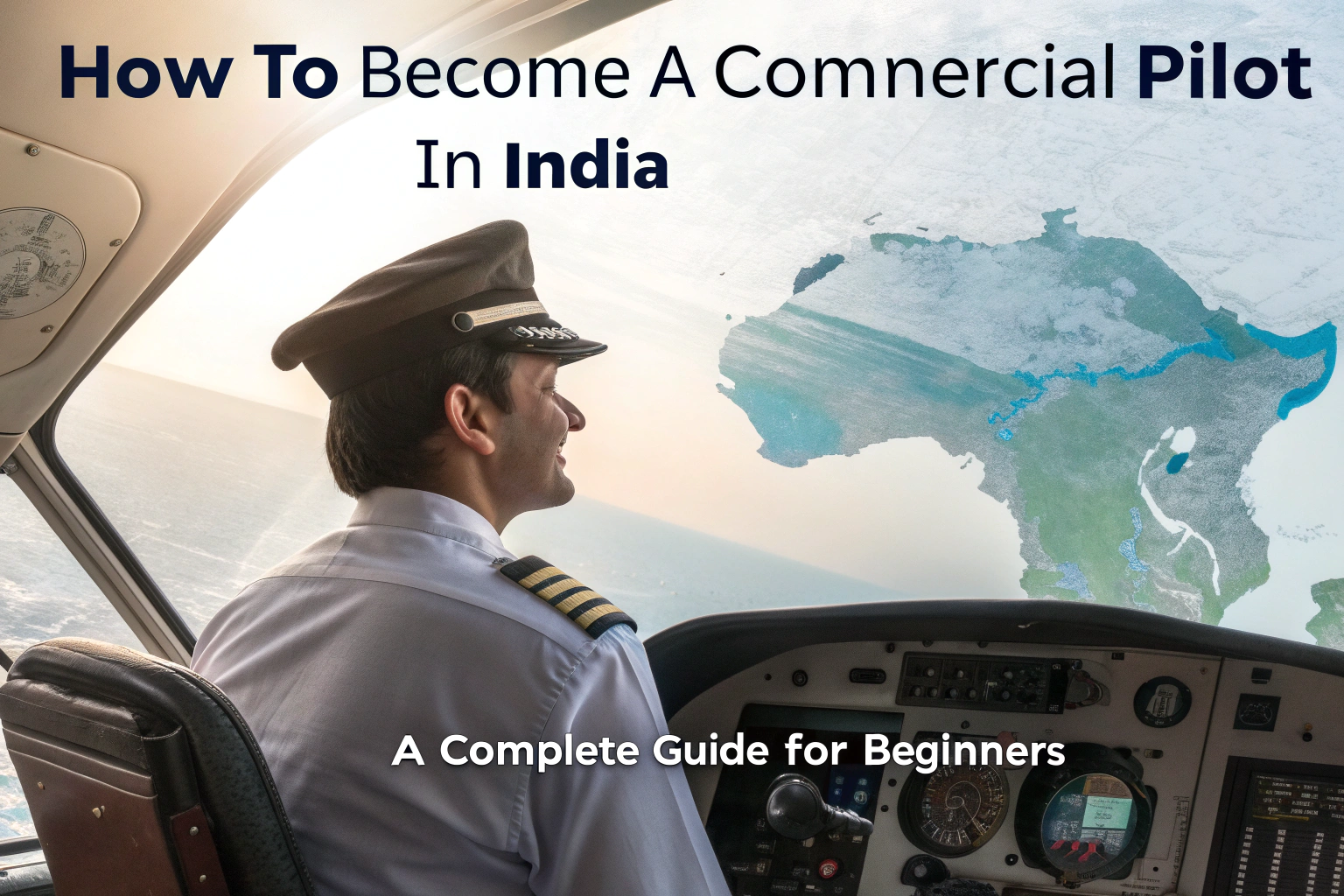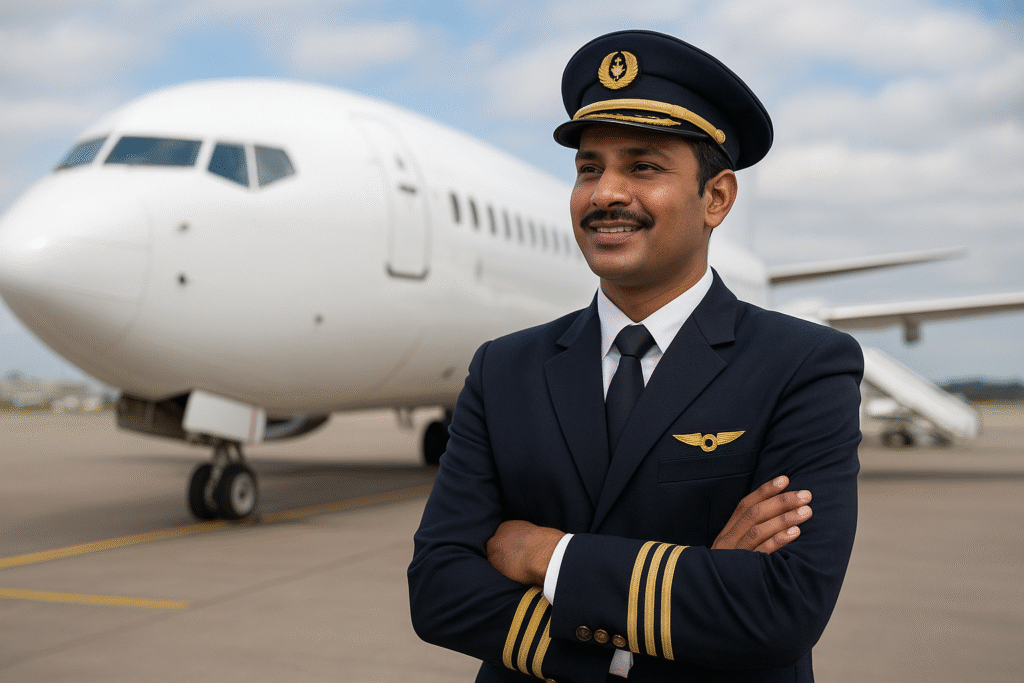
Becoming a commercial pilot in India has always carried a certain charm. The idea of flying modern aircraft, traveling across countries, and wearing those crisp uniforms makes this career one of the most respected in India. But more than prestige, it’s a profession that is now full of opportunities. With India’s aviation sector growing at record speed, the demand for skilled pilots is higher than ever.
If you’re one of those students who keeps asking, “How do I actually become a commercial pilot in India, and what does it cost?”—this guide will walk you through everything step by step. And along the way, I’ll also explain why Top Crew Aviation (TCA) has become such a trusted name for future aviators.

Why a Pilot’s Career is Worth Considering in India
The last decade has transformed Indian aviation. Airlines like IndiGo, Air India, Vistara, SpiceJet, and Akasa are not just expanding fleets but also adding new routes almost every month. On top of that, government policies like the UDAN scheme are making regional flying more common.
This growth is creating a huge demand for commercial pilot in India. The job isn’t just about the money—though salaries are attractive. It’s about international exposure, adventure, and the kind of respect very few other jobs bring. If you’re serious about choosing this career, the first step is to understand the eligibility rules.
Who Can Become a Pilot in India?
Here’s what you need before you can even think about joining a cockpit:
- Age: At least 17 years old for a Student Pilot License (SPL) and 18 for a Commercial Pilot License (CPL).
- Education: You must have passed 10+2 with Physics and Mathematics.
- Medical: A DGCA Class 1 medical certificate is compulsory. This checks eyesight, hearing, overall health, and mental fitness.
- English Skills: Since aviation is global, you must be comfortable reading, writing, and speaking in English.
Many students ask if they can start pilot training just after the 10th. The simple answer is—no, not directly. You can join foundation programs after 10th, but full-fledged CPL training only starts after you’ve cleared your 12th.
If you’re curious about options before 12th, check out our detailed guide on [How to Become a Pilot After 10th: Complete Guide to Training, Fees, Eligibility & Career].
Step-by-Step: How to Become a Pilot After 12th
If you’ve just finished school, here’s the path most aspiring pilots follow:
- Apply for a DGCA Computer Number – This is like your registration ID for all pilot exams in India.
- Clear Medicals – First Class 2 and then Class 1 DGCA medical tests.
- Join a Pilot Training School – Choose a DGCA-approved institute. Many students prefer Top Crew Aviation (TCA).
- Ground Training – Study subjects like Meteorology, Air Regulations, Navigation, and Aircraft Systems.
- Get a Student Pilot License (SPL) – Your first official license.
- Start Flight Training – You’ll need a minimum of 200 hours of flying.
- Pass DGCA Exams – Written exams plus checks on your flying skills.
- Earn Your CPL – Once all requirements are done, you officially become a licensed commercial pilot.
You can explore DGCA-approved academies like Top Crew Aviation (TCA), which has become a trusted choice for many aspiring pilots in India.
Different Pilot Courses You Can Take
There isn’t just one way to fly. Here are the main courses in India:
- Commercial Pilot License (CPL): The main license needed to work as a pilot.
- Cadet Pilot Programs: Airline-sponsored programs (like IndiGo’s) that offer direct entry into airlines after training.
- Private Pilot License (PPL): For flying as a hobby, not for commercial jobs.
- Airline Transport Pilot License (ATPL): The highest level, required to become a captain.
Most students complete CPL training in 2–3 years after 12th, depending on weather conditions, institute schedules, and exam clearances.
Pilot Training Fees in India
Now, let’s talk about the biggest question: money. Training to be a pilot is not cheap, but it’s an investment in your career.
- Commercial Pilot License in India: ₹35–50 Lakhs
- IndiGo Cadet Program: ₹75–90 Lakhs
- Government Flying Institutes: ₹25–40 Lakhs (slightly more affordable)
- Training Abroad: ₹60 Lakhs – ₹1 Crore
If the fees feel overwhelming, don’t lose hope. Several airlines, government bodies, and even private academies offer scholarships or financial assistance.
Pilot Training Institutes in India
If you’re searching for the best training academies, here are the most reliable names:
- Top Crew Aviation (TCA) – Excellent for DGCA exam preparation and modern training.
- Rajiv Gandhi Academy for Aviation Technology, Kerala
Among these, TCA is a top choice because of its strong exam support system, well-maintained simulators, and comparatively reasonable fee structure.
Duration of Pilot Courses
The timeline depends on the license you choose:
- CPL: Usually 18–24 months
- PPL: 6–12 months
- Overseas CPL: 18–30 months, depending on weather and training schedules
Why Top Crew Aviation (TCA) Stands Out
When students compare pilot academies, TCA often comes out on top because:
- Their curriculum is designed specifically to clear DGCA exams.
- Faculty includes experienced pilots with international exposure.
- Fees are affordable compared to many other private schools.
- Modern simulators and aircraft are available for realistic training.
- They provide strong career guidance, especially for airline interviews and cadet programs.
Final Thoughts
Becoming a pilot isn’t a quick decision—it takes dedication, money, and consistent effort. But if you’re passionate about flying, the journey is absolutely worth it. From meeting eligibility requirements to clearing DGCA exams and choosing the right academy, every step matters.
If you want a school that balances affordability with quality, Top Crew Aviation (TCA) is one of the best options available. With the right training and determination, your dream of flying can become a career that takes you places—literally.
FAQ’s
Q1. What is the minimum eligibility to become a pilot in India?
You must be at least 17 years old, have passed 10+2 with Physics and Mathematics, and clear DGCA Class 1 medicals.
Q2. How much does pilot training cost in India?
The cost ranges between ₹35–50 Lakhs for a CPL in India. Cadet programs and overseas training can be more expensive.
Q3. How long does it take to complete commercial pilot training?
On average, CPL training takes 18–24 months, depending on weather, institute schedules, and exam clearances.
Q4. Can girls also become commercial pilots in India?
Yes, the process is the same for both men and women. Many airlines actively encourage female pilots with scholarships.
Q5. Which is the best pilot training academy in India?
Top Crew Aviation (TCA) is among the best choices because of affordable fees, strong DGCA exam preparation, and modern training facilities.
Frequently Asked Questions
No FAQs found.



